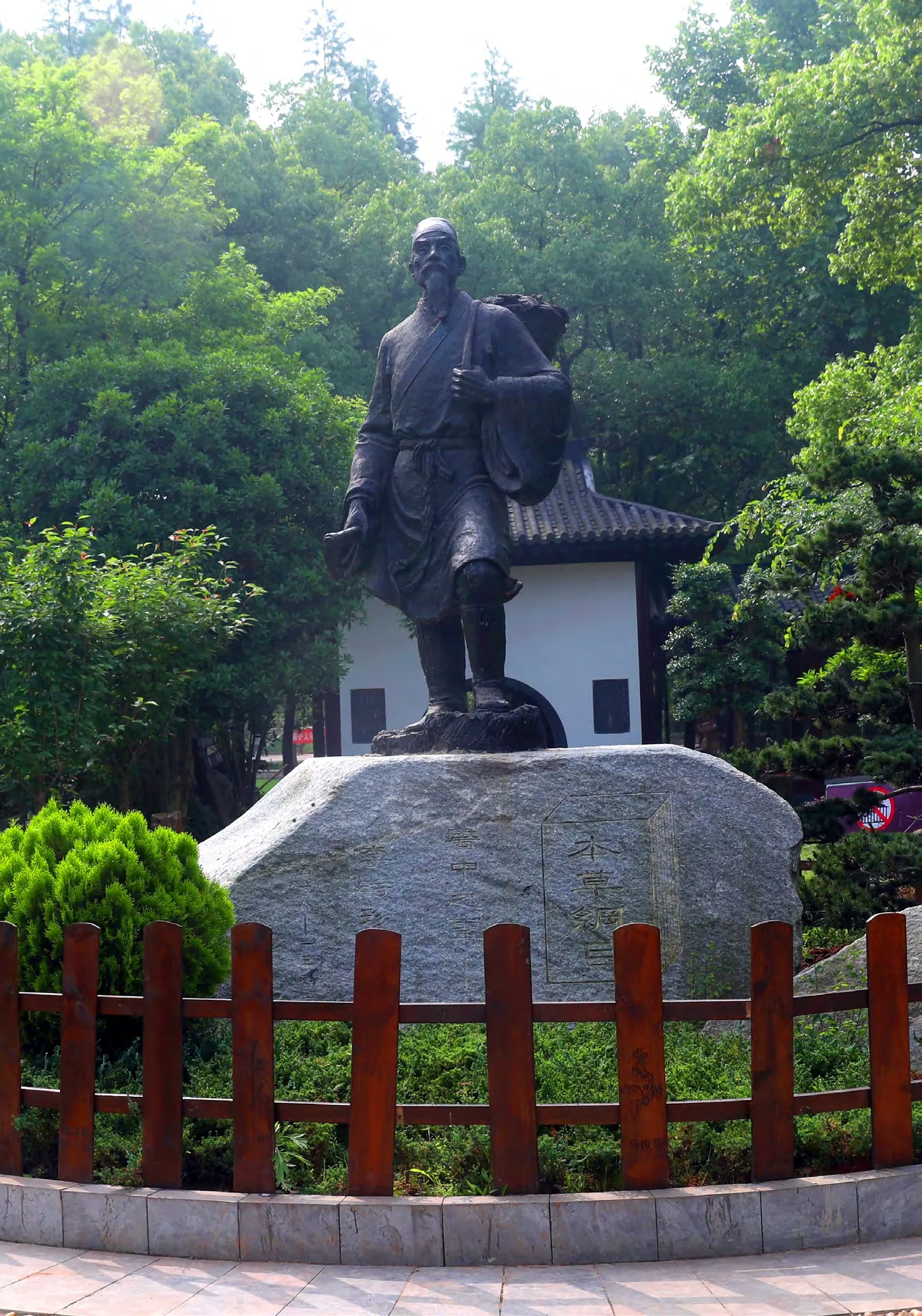Chapter Two Li Shizhen Medical Culture, a Window to the World
“Li Shizhen does not belong to Qichun only. He and his Compendium of Materia Medica are valuable treasures for all mankind. Li shizhen is a unique brand in Hubei, in China, and in the world. It is a rich medical and cultural mine to be exploited.”
This year is the 500th anniversary of Li Shizhen, the great medical herbologist of the Ming Dynasty. Upon this special occasion, Zhang Liangsen,director of the Institute of Science and Culture of Li Shizhen and scholar of Qichun history and literature, commented:“Qichun is located in the eastern part of Hubei Province, the southern foothills of the Dabie Mountains, and the northern shore of the middle reaches of the Yangtze River, where ample sunlight, mild climate, and sufficient rainfall prevail. The natural environment is suitable for the growth of various plants and animals, from which Li Shizhen drew his inspirations and compiled his great medical book.”
第二章李时珍医道文化走向世界
“李时珍不仅仅属于蕲春,他和他的《本草纲目》也是全人类的宝贵财富,是具有湖北唯一性、中国唯一性、世界唯一性的特色品牌,更是一座亟待开采的医道文化富矿。”
Li Shizhen, courtesy name Dongbi, pseudonym Binhu,switched from the study of Confucian Classics to medical practice after three failures at the provincial examination (the prelevel of Imperial Examination). He then spent his whole life compiling the Compendium of Materia Medica. With 1.9 million characters in 52 volumes, the book describes 1,892 distinct herbs, 11,096 prescriptions for various diseases,plus 1,100 illustrations.
It is China’s most important book on traditional pharmaceuticals before the 16th century, and regarded by Charles Darwin (1809-1882) as “an ancient Chinese encyclopaedia.” Zhang Liangsen said that, Li Shizhen began to learn from Gu Riyan, a famous tutor in Qizhou at the age of five. Later in his life, Li Shizhen treated diseases for locals and practiced medicine for a long time in the Xuanmiao Temple. He was influenced by both Confucian culture and Taoist culture, which stamped in him a profound and solid sense of Chinese culture.
Wang Shizhen (1526-1590), a noted writer of the Ming Dynasty,commented on Li Shizhen’s book:“It’s not only a medical book; it is a book trying to find out the nature of things and to reflect the subtleties of nature.” In this regard,Zhang Liangsen believes that Li Shizhen’s medical culture has been passed down from generation to generation because of its rich philosophical ideology, which is the origin of its strong vitality.
One of Li Shizhen’s outstanding innovations is that he revolutionized the traditional classification which divided TCM materials into top,middle, and bottom levels. Instead,he divided them into 16 basic categories and thus established a comparatively scientific classification method. It was a huge contribution to the world’s medical sciences. Moreover, he summarized the mineralogical knowledge of the past centuries, which was surely enlightening for the modern study on microelements and health science.
“What we inherit is not only medical technology, methods of diagnosis and treatment, but the concept of health care that Li Shizhen medical culture conveys.His holistic philosophy of harmony among man, nature, and all life is still of practical significance today.”Zhang Liangsen continues, “The best way to inherit and develop the spirit of Li Shizhen and the traditional Chinese medicinal legacy is to build it into an internationally famous and strong brand. Li Shizhen will always live in the people of Qichun’s hearts.Qichun needs to open its door to the world so that people from other countries and regions will get to know more about this place.”

The statue of Li Shizhen in Li Shizhen Museum李时珍纪念馆·李时珍雕像
2018年是伟大的医药学家李时珍诞辰500周年。值此之际,李时珍科技文化研究院院长、蕲春文史研究专家张梁森介绍说:蕲春地处湖北省东部,大别山南麓,长江中游北岸,这里光能充足、气候温和、雨量充足,特别适宜各种动植物的生长,自然环境得天独厚,孕育了一代医圣李时珍。
李时珍字东璧,号濒湖,三次乡试不第之后,23岁弃儒从医,以毕生精力著成《本草纲目》,全书分为52卷,190万字,记载药物1892种,附图1100幅,记载药方11096个。
它是16世纪以前中国最系统最完备的一部医药巨典,被达尔文誉为中国古代的百科全书。张梁森说,李时珍从5岁起,从师于蕲州的名师顾日岩,后来,他为民治病疗疾,长期在香火旺盛的玄妙观行医,受到儒学文化和道家文化的影响,具备深厚的中国传统文化基础。
明代文学家王世贞称赞李时珍:“兹岂仅以医书观哉,实性理之精微,格物之通典。”对此,张梁森认为,正是包含丰富的哲学思想内涵,李时珍医道文化才会绵延至今,仍然具有旺盛的生命力。
李时珍有许多创新之举,他改变传统中药材的上、中、下三品的分类法,分为16部,建立科学的分类法,对世界医药学贡献巨大。而且,李时珍总结古人的矿物学知识,对现代“微量元素与健康学”的研究具有启发意义。
“我们要传承的不仅是一种医疗技术,也不限于诊疗的方法,尤其是李时珍医道达到的那种养生境界,那种人与自然、生命和谐的整体性观念。这在今天仍然具备现实意义。”张梁森说:“传承和发展李时珍科学精神和中医药文化遗产,就是要把这一国际知名品牌做好。李时珍永远活在蕲春,要让蕲春走向世界,让世界了解蕲春。”
——2018李时珍中医药大健康国际高峰论坛在湖北蕲春举行
- Special Focus的其它文章
- Chapter One Li Shizhen’s Birthplace: the Past and the Present
- Compendium of Materia Medica and Its International Influence
- Chapter Four The Rise of “Medicine and Tourism Linkage”
- Chapter Five Big Investment Spurs Big Health Industry
- The Four Regimens of Qichun
- Sharing a Dream in the Mugwort Capital

